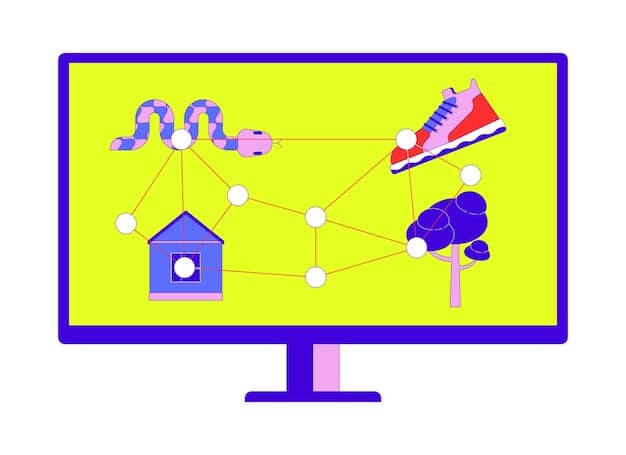Will Fall 2025 Network TV See a 15% Streaming Boost?

Whether the Fall 2025 network TV lineup will see a 15% increase in streaming viewership depends on factors like content quality, marketing strategies for streaming platforms, changes in consumer viewing habits, and competitive offerings from streaming-only services.
Will the Fall 2025 network TV lineup break records in streaming viewership? The question of whether it will experience a 15% increase is complex, touching on several crucial factors influencing viewing habits.
The Evolving Landscape of Network Television
The television landscape is constantly evolving, with streaming services becoming increasingly dominant. To understand whether the Fall 2025 network TV lineup could see a 15% increase in streaming viewership, it’s crucial to examine the current state of network TV and its ongoing adaptation to compete in this dynamic environment.
The Decline of Traditional Viewership
Traditional network television has faced a steady decline in viewership over the past decade. This shift is primarily attributed to the convenience and vast content libraries offered by streaming platforms. However, network TV still holds a significant audience, particularly for live events, news, and sports.
Network Strategies to Embrace Streaming
Networks are actively adapting by launching their streaming platforms or partnering with existing ones. This allows them to offer content on-demand, reaching a broader audience and combating cord-cutting. The success of these strategies will be a key factor in determining future viewership trends.
- Content Investments: Networks are investing heavily in exclusive streaming content.
- Bundling Services: Some networks are exploring bundling their streaming services.
- Live Streaming: Networks are also focusing on live streaming events.
In conclusion, the ability of network TV to adapt and cater to changing consumer preferences will be crucial in determining whether the Fall 2025 lineup can attract a significant audience to streaming platforms. Strategic content investments and innovative distribution methods are essential for success.

Factors Influencing Streaming Viewership
Numerous factors will influence the streaming viewership of the Fall 2025 network TV lineup. Understanding these elements is crucial for predicting potential growth and identifying strategies to maximize audience engagement on streaming platforms.
Content Quality and Relevance
The quality and relevance of the content offered are paramount in attracting and retaining viewers. Original and compelling shows are more likely to drive streaming subscriptions and engagement.
Marketing and Promotion Strategies
Effective marketing and promotion are essential for driving awareness and viewership. Tailored strategies that target different demographics and leverage social media can significantly impact streaming numbers.
- Social Media Campaigns: Engaging campaigns on platforms like TikTok and Instagram.
- Cross-Promotion: Leveraging network TV to promote streaming content.
- Influencer Marketing: Partnering with influencers to reach new audiences.
In summary, content excellence combined with strategic marketing efforts will significantly shape the streaming viewership outcomes for the Fall 2025 network TV lineup. A focus on audience preferences and innovative promotional tactics is essential.
Competitive Landscape: Streaming vs. Network TV
The competition between streaming services and network TV is fierce. To predict the streaming viewership of the Fall 2025 network TV lineup, we must thoroughly examine the competitive dynamics at play between these two entertainment powerhouses.
Rise of Streaming-Only Services
Streaming services like Netflix, Amazon Prime Video, and Disney+ have captured a significant portion of the viewing audience with their vast libraries and original content. These platforms continue to innovate and expand their offerings.
Network TV’s Unique Advantages
Despite the rise of streaming, network TV retains advantages, particularly in live events, news, and sports. These remain strong draws for traditional TV viewing and can be leveraged to drive streaming subscriptions.

Understanding the strengths and weaknesses of both streaming services and network TV is crucial for predicting future viewership trends. Networks must leverage their unique assets to compete effectively in the streaming landscape.
Consumer Viewing Habits and Trends
Consumer viewing habits are rapidly evolving, influenced by changing technology, availability of content, and personal preferences. These trends play a vital role in predicting the streaming success of the Fall 2025 network TV lineup.
Cord-Cutting and Cord-Nevers
The trend of cord-cutting, where viewers cancel their cable subscriptions in favor of streaming services, continues to grow. Additionally, there is an increasing number of “cord-nevers” who have never subscribed to traditional cable.
On-Demand and Binge-Watching
On-demand viewing and binge-watching have become mainstream behaviors, driven by the convenience and extensive libraries offered by streaming platforms. Networks must adapt their content release strategies to cater to these viewing habits.
- Releasing Full Seasons: Considering releasing entire seasons at once.
- Creating Binge-Worthy Content: Focusing on compelling narratives.
- Optimizing for Mobile Viewing: Ensuring content is accessible on various devices.
Adapting to the changing viewing habits is essential for networks to capture a larger share of the streaming audience. Strategies that cater to on-demand viewing and mobile access will be crucial for success.
Strategies for Increasing Streaming Viewership
To achieve a 15% increase in streaming viewership for the Fall 2025 network TV lineup, networks must implement targeted and innovative strategies. These strategies should focus on content, marketing, and technology to maximize engagement.
Investing in Original Content
Creating compelling and exclusive original content is vital for attracting streaming subscribers. These shows should be high-quality, diverse, and cater to a wide range of audiences.
Leveraging Data Analytics
Data analytics can provide valuable insights into viewer preferences and behaviors. Networks can use this data to personalize content recommendations, improve marketing strategies, and enhance the overall viewing experience.
By leveraging data analytics and creating original content that resonates with viewers, networks can significantly increase streaming viewership. These strategies require a deep understanding of audience preferences and behaviors.
Potential Outcomes and Projections
Predicting whether the Fall 2025 network TV lineup will see a 15% increase in streaming viewership requires considering various potential outcomes and making informed projections based on current trends and strategies.
Best-Case Scenario
In an optimistic scenario, networks successfully invest in high-quality original content, implement effective marketing strategies, and capitalize on changing consumer viewing habits. This could result in a significant increase in streaming viewership, potentially exceeding the 15% target.
Worst-Case Scenario
In a pessimistic scenario, networks fail to adapt to the changing landscape, struggle to compete with streaming-only services, and see a continued decline in traditional viewership without a corresponding increase in streaming engagement. This could result in stagnant or even declining streaming numbers.
The actual outcome will likely fall somewhere between these two extremes. Success depends on the ability of networks to adapt, innovate, and effectively compete in the evolving media landscape.
| Key Point | Brief Description |
|---|---|
| 📺 Content Quality | High-quality, original shows are vital for attracting viewers. |
| 📈 Marketing Strategies | Effective promotion drives awareness and viewership growth. |
| 📱 Viewing Habits | Adapting to on-demand and mobile viewing is crucial. |
| 📊 Data Analytics | Data insights personalize content and improve strategies. |
Frequently Asked Questions
▼
Streaming viewership growth is influenced by content quality, marketing strategies, competitive landscape, consumer viewing habits, and technological advancements.
▼
Networks are adapting by launching their streaming platforms, investing in original content, and bundling services to attract and retain viewers.
▼
Cord-cutting is the trend of viewers canceling cable subscriptions, impacting networks by reducing traditional TV viewership and revenue streams.
▼
Data analytics help personalize content recommendations, improve marketing strategies, and enhance the overall viewing experience by understanding viewer behavior.
▼
Mobile viewing is crucial as it allows viewers to access content on various devices, catering to on-the-go and convenient viewing habits.
Conclusion
In conclusion, whether the Fall 2025 network TV lineup will achieve a 15% increase in streaming viewership hinges on strategic content investments, effective marketing, adaptation to changing consumer habits, and the ability to compete with streaming-only services. The outcome remains uncertain but presents both challenges and opportunities for network television.





